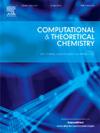Regulating fluorescent properties and ESIPT behavior of novel scaffold-based fluorescent molecule by different substituents: A TD-DFT study
IF 3
3区 化学
Q3 CHEMISTRY, PHYSICAL
引用次数: 0
Abstract
Recently, a new fluorophore 5-bis(benzo[d]thiazol-2-yl)phenol (BTP) is synthesized experimentally, and BTP-based probe can successfully recognize cysteine (Cys) quickly and sensitively (Spectrochim. Acta Part A 217 (2019) 1–7). Via introducing the –CN and/or –N(CH3)2 groups into BTP, three novel compounds (BTP-1, BTP-2 and BTP-3) are designed to investigate the substituent effects on the photophysical properties and excited state intramolecular proton transfer (ESIPT) process of BTP. The structural parameters, infrared (IR) vibrational spectra, electron densities and reduced density gradient (RDG) isosurfaces obtained by density functional theory (DFT) and time-dependent DFT (TD-DFT) methods have indicated that the intramolecular hydrogen bonds (IHBs) of BTP derivatives became stronger in the excited (S1) state. The introduction of substituent leads to a bathochromic-shift of the absorption and fluorescence peaks. Meanwhile, from the potential energy curves, it can be found that the introduction of two –CN groups can effectively decrease the ESIPT energy barrier of BTP, while the coexistence of –CN and –N(CH3)2 hinder the ESIPT process.

不同取代基对新型支架荧光分子荧光特性和ESIPT行为的调控:TD-DFT研究
最近,实验合成了一种新的荧光基团5-双(苯并[d]噻唑-2-基)苯酚(BTP), BTP探针可以快速、灵敏地识别半胱氨酸(Cys)。Acta A Part 217(2019) 1-7)。通过在BTP中引入-CN和/或-N (CH3)2基团,设计了3个新化合物(BTP-1、BTP-2和BTP-3),研究取代基对BTP光物理性质和激发态分子内质子转移(ESIPT)过程的影响。利用密度泛函理论(DFT)和时间依赖DFT (TD-DFT)方法获得的BTP衍生物的结构参数、红外(IR)振动谱、电子密度和还原密度梯度(RDG)等面表明,BTP衍生物在激发态(S1)下分子内氢键(IHBs)变得更强。取代基的引入导致吸收峰和荧光峰发生色移。同时,从势能曲线可以发现,两个-CN基团的引入可以有效降低BTP的ESIPT能垒,而-CN和-N (CH3)2的共存阻碍了ESIPT过程。
本文章由计算机程序翻译,如有差异,请以英文原文为准。
求助全文
约1分钟内获得全文
求助全文
来源期刊

Computational and Theoretical Chemistry
CHEMISTRY, PHYSICAL-
CiteScore
4.20
自引率
10.70%
发文量
331
审稿时长
31 days
期刊介绍:
Computational and Theoretical Chemistry publishes high quality, original reports of significance in computational and theoretical chemistry including those that deal with problems of structure, properties, energetics, weak interactions, reaction mechanisms, catalysis, and reaction rates involving atoms, molecules, clusters, surfaces, and bulk matter.
 求助内容:
求助内容: 应助结果提醒方式:
应助结果提醒方式:


